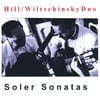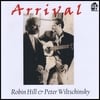The second track on 'Arrival' is 'La Vecchia Pavane and Galliard', by John Johnson (1540-1595).
A Pavane is a Court dance of the 16th and early 17th century, which is usually sedate, and often an introduction for a processional dance.
The pavane consists of two single steps and one double step forward, followed by two single steps and one double step backwards. It's played in duple time, 2 or 4 beats to the bar.
The Galliard is much livelier, a triple-metre dance, usually with regular phrase structures of 8, 12, or 16 bars, with a step-pattern of five movements taken to six minims, which is similar to that of the salterello, except that the steps are higher and more vigorously executed.
As you listen to these pieces, you can easily imagine the ladies and gentlemen of the Elizabethan Court enjoying the music and joining in, starting with the slow Pavane and moving on to the more energetic Galliard.
'La Vecchia' simply means old.
At this time it was common for lutenists to undertake the position of an apprentice within a noble house, often from a very early age.
This was an essential process for any musician of 'low birth' to make contacts with the wealthy aristocracy, which would then allow them access to the Royal Courts.
The modern day equivalent would presumably be blogs, MySpace, Twitter, and the like, the modern way of networking.
Whilst records are difficult to trace, it is thought that Johnson would have undertaken an apprentice position in a noble house, likely to be that of the Earl of Leicester.
His skill as a lutenist didn't go unnoticed though, and by 1577 he had entered the Royal services of Her Majesty's Musicians for the three lutes, along with Mathias Mason and Thomas Cardell. The number rising to six or seven lutenists as the popularity of the instrument increased.
John Johnson is regarded as the founder of the school of English lute music of the 'Golden Age', which culminated in the works of John Dowland.
Johnson's playing must have been exceptional, and it is believed that he was Queen Elizabeth I favourite lutenist, but his importance also lies within the huge body of works available today.
His manuscripts have been found all over Europe even though it's thought that Johnson never left England, a feat only matched, and exceeded, by John Dowland himself.
The musical tradition continued with his son, Robert Johnson (1582-1633), also a lutenist, but he was connected with Elizabethan Acting Troupes, working with playwrights such as William Shakespeare, Beaumont and Fletcher.
So, 'La Vecchia Pavane and Galliard' is steeped in the lute tradition, although Johnson developed the lute duet to an unprecedented level of technical and musical excellence. With complete equality of parts being one of the striking features of Johnson's work.
Johnson was certainly more prolific than any of his English contemporaries, and 'La Vecchia Pavane and Galliard' together make a fine example of the conversational style of the Elizabethan lute duet.
The guitar repertoire is greatly enriched by the assimilation of the lute's vast body of works, in this recording the guitars are played with capos at the third fret to create a more lute-like sonority.
Reviews
'As always, it was sheer pleasure to observe Robin Hill's remarkable fluent technique: everything looks easy when he plays it.' Colin Cooper- Classical Guitar Magazine -----
'Wonderful for their (Hill & Wiltschinsky) precision, touch and clarity of sound... refined virtuosity, the achievement of a long interpretive process.' Il Giornale D'Italia (Rome) -----
'I loved your CD and thought your technique and performance were fabulous...' Rick Wakeman
Subscribe to:
Post Comments (Atom)


















No comments:
Post a Comment